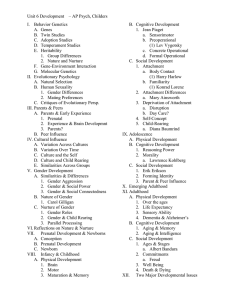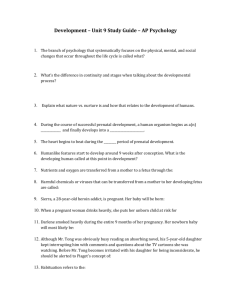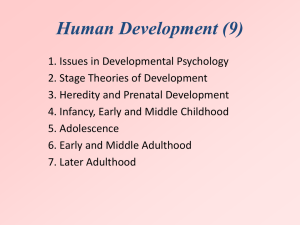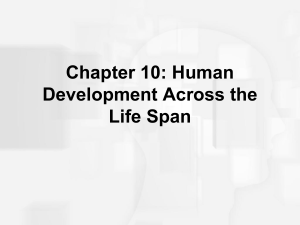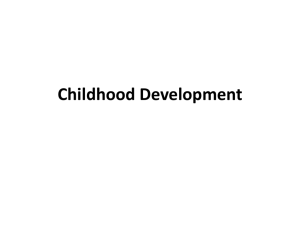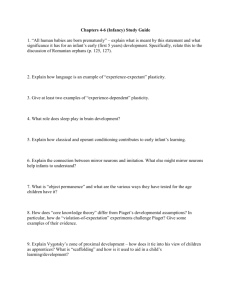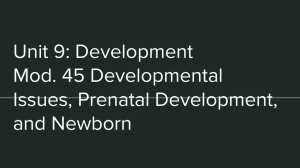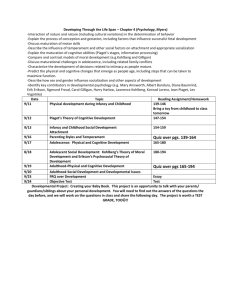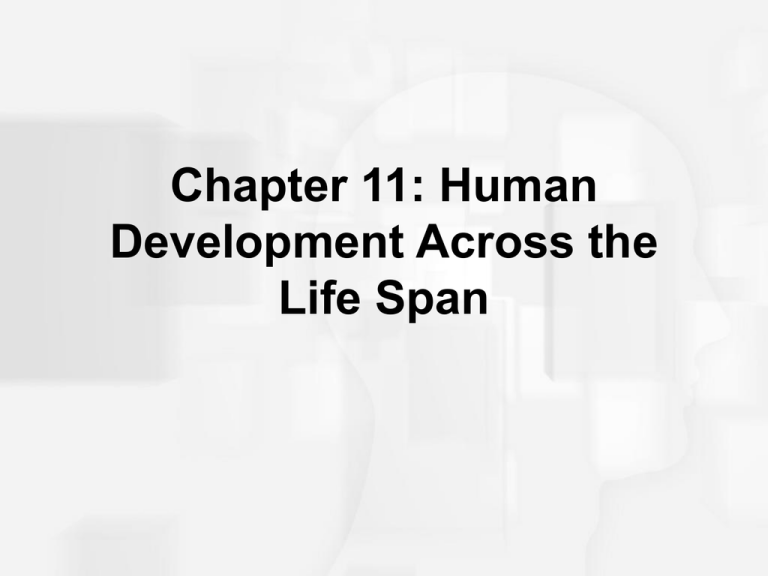
Chapter 11: Human
Development Across the
Life Span
Progress Before Birth:
Prenatal Development
• 3 phases
– germinal stage = first 2 weeks
• conception, implantation, formation of
placenta
– embryonic stage = 2 weeks – 2 months
• formation of vital organs and systems
– fetal stage = 2 months – birth
• bodily growth continues, movement
capability begins, brain cells multiply
• age of viability
Figure 11.1 Overview of fetal development
Environmental Factors
and Prenatal Development
• Maternal nutrition
– Malnutrition linked to increased risk of birth
complications, neurological problems, and
psychopathology
• Maternal drug use
– Tobacco, alcohol, prescription, and
recreational drugs
– Fetal alcohol syndrome
Environmental Factors
and Prenatal Development
• Maternal illness
– Rubella, syphilis, mumps, genital herpes,
AIDS, severe influenza
– Prenatal health care
– Prevention through guidance
The Childhood Years: Motor Development
• Basic Principles
– Cephalocaudal trend – head to foot
– Proximodistal trend – center-outward
• Maturation – gradual unfolding of genetic
blueprint
• Developmental norms – median age
– Cultural variations
Easy and Difficult Babies:
Differences in Temperament
• Longitudinal vs. cross-sectional designs
• Thomas, Chess, and Birch (1970)
– 3 basic temperamental styles
• easy – 40%
• slow-to-warm-up – 15%
• difficult – 10%
• mixed – 35%
–stable over time
Easy and Difficult Babies:
Differences in Temperament
• Kagan & Snidman (1991)
– Inhibited vs. uninhibited temperament
• inhibited – 15 - 20%
• uninhibited – 25 - 30%
–stable over time, genetically based
Figure 11.6 Longitudinal versus cross-sectional research
Early Emotional Development: Attachment
• Separation anxiety
– Ainsworth (1979)
– The strange situation and patterns of attachment
• Secure
• Anxious-ambivalent
• Avoidant
• Developing secure attachment
– Bonding at birth
– Daycare
– Cultural factors
• Evolutionary perspectives on attachment
Stage Theories of Development: Personality
• Stage theories, three components
– progress through stages in order
– progress through stages related to age
– major discontinuities in development
• Erik Erikson (1963)
– Eight stages spanning the lifespan
– Psychosocial crises determining balance
between opposing polarities in personality
Figure 11.10 Stage theories of development
Figure 11.11 Erikson’s stage theory
Stage Theories: Cognitive Development
• Jean Piaget (1920s-1980s)
– Assimilation/ Accommodation
– 4 stages and major milestones
• Sensorimotor
– Object permanence
• Preoperational
– Centration, Egocentrism
• Concrete Operational
– Decentration, Reversibility, Conservation
• Formal Operational
– Abstraction
Figure 11.12 Piaget’s stage theory
Figure 11.13 Piaget’s conservation task
Figure 11.14 The gradual mastery of conservation
The Development of Moral Reasoning
• Kohlberg (1976)
– Reasoning as opposed to behavior
• Moral dilemmas
–Measured nature and progression of
moral reasoning
– 3 levels, each with 2 sublevels
• Preconventional
• Conventional
• Postconventional
Figure 11.17 Kohlberg’s stage theory
Adolescence: Physiological Changes
• Pubescence
• Puberty
– Secondary sex characteristics
– Primary sex characteristics
• Menarche
• Sperm production
– Maturation: early vs. late
• Sex differences in effects of early
maturation
Figure 11.19 Physical development at puberty
Adolescence: Neural Changes
• Increasing myelinization
• Synaptic pruning
• Changes in prefrontal cortex
The Search for Identity
• Erik Erikson (1968)
– Key challenge - forming a sense of identity
• James Marcia (1988)
– 4 identity statuses
• Foreclosure
• Moratorium
• Identity Diffusion
• Identity Achievement
The Expanse of Adulthood
•
•
•
•
•
Personality development
Social development
Career development
Physical changes
Cognitive changes



